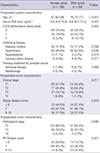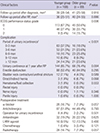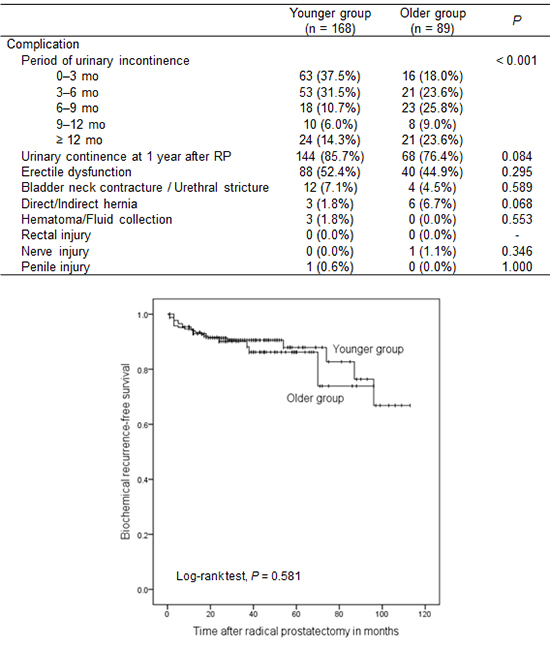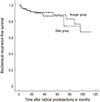2. Heinzer H, Steuber T. Prostate cancer in the elderly. Urol Oncol. 2009; 27:668–672.
3. Bechis SK, Carroll PR, Cooperberg MR. Impact of age at diagnosis on prostate cancer treatment and survival. J Clin Oncol. 2011; 29:235–241.
4. Mohler J, Bahnson RR, Boston B, Busby JE, D’Amico A, Eastham JA, Enke CA, George D, Horwitz EM, Huben RP, et al. NCCN clinical practice guidelines in oncology: prostate cancer. J Natl Compr Canc Netw. 2010; 8:162–200.
5. Middleton RG. The management of clinically localized prostate cancer: guidelines from the American Urological Association. CA Cancer J Clin. 1996; 46:249–253.
6. Heidenreich A, Bastian PJ, Bellmunt J, Bolla M, Joniau S, van der Kwast T, Mason M, Matveev V, Wiegel T, Zattoni F, et al. EAU guidelines on prostate cancer. part 1: screening, diagnosis, and local treatment with curative intent-update 2013. Eur Urol. 2014; 65:124–137.
7. Schwartz KL, Alibhai SM, Tomlinson G, Naglie G, Krahn MD. Continued undertreatment of older men with localized prostate cancer. Urology. 2003; 62:860–865.
8. Bubolz T, Wasson JH, Lu-Yao G, Barry MJ. Treatments for prostate cancer in older men: 1984-1997. Urology. 2001; 58:977–982.
9. Richstone L, Bianco FJ, Shah HH, Kattan MW, Eastham JA, Scardino PT, Scherr DS. Radical prostatectomy in men aged >or=70 years: effect of age on upgrading, upstaging, and the accuracy of a preoperative nomogram. BJU Int. 2008; 101:541–546.
10. Konety BR, Cowan JE, Carroll PR. CaPSURE Investigators. Patterns of primary and secondary therapy for prostate cancer in elderly men: analysis of data from CaPSURE. J Urol. 2008; 179:1797–1803.
11. Ketchandji M, Kuo YF, Shahinian VB, Goodwin JS. Cause of death in older men after the diagnosis of prostate cancer. J Am Geriatr Soc. 2009; 57:24–30.
12. Manton KG, Vaupel JW. Survival after the age of 80 in the United States, Sweden, France, England, and Japan. N Engl J Med. 1995; 333:1232–1235.
13. Pfitzenmaier J, Pahernik S, Buse S, Haferkamp A, Djakovic N, Hohenfellner M. Survival in prostate cancer patients > or = 70 years after radical prostatectomy and comparison to younger patients. World J Urol. 2009; 27:637–642.
14. Pierorazio PM, Humphreys E, Walsh PC, Partin AW, Han M. Radical prostatectomy in older men: survival outcomes in septuagenarians and octogenarians. BJU Int. 2010; 106:791–795.
15. Malaeb BS, Rashid HH, Lotan Y, Khoddami SM, Shariat SF, Sagalowsky AI, McConnell JD, Roehrborn CG, Koeneman KS. Prostate cancer disease-free survival after radical retropubic prostatectomy in patients older than 70 years compared to younger cohorts. Urol Oncol. 2007; 25:291–297.
16. Namiki S, Ishidoya S, Tochigi T, Ito A, Arai Y. Quality of life after radical prostatectomy in elderly men. Int J Urol. 2009; 16:813–819.
17. Froehner M, Koch R, Litz RJ, Hakenberg OW, Oehlschlaeger S, Wirth MP. Comorbidity is poor predictor of survival in patients undergoing radical prostatectomy after 70 years of age. Urology. 2006; 68:583–586.
18. Poulakis V, Witzsch U, de Vries R, Dillenburg W, Becht E. Laparoscopic radical prostatectomy in men older than 70 years of age with localized prostate cancer: comparison of morbidity, reconvalescence, and short-term clinical outcomes between younger and older men. Eur Urol. 2007; 51:1341–1348.
19. Stangelberger A, Waldert M, Djavan B. Prostate cancer in elderly men. Rev Urol. 2008; 10:111–119.
20. Alibhai SM, Krahn MD, Cohen MM, Fleshner NE, Tomlinson GA, Naglie G. Is there age bias in the treatment of localized prostate carcinoma? Cancer. 2004; 100:72–81.
21. Albertsen PC, Hanley JA, Gleason DF, Barry MJ. Competing risk analysis of men aged 55 to 74 years at diagnosis managed conservatively for clinically localized prostate cancer. JAMA. 1998; 280:975–980.
22. Greco KA, Meeks JJ, Wu S, Nadler RB. Robot-assisted radical prostatectomy in men aged > or =70 years. BJU Int. 2009; 104:1492–1495.
23. Kupelian PA, Potters L, Khuntia D, Ciezki JP, Reddy CA, Reuther AM, Carlson TP, Klein EA. Radical prostatectomy, external beam radiotherapy <72 Gy, external beam radiotherapy > or =72 Gy, permanent seed implantation, or combined seeds/external beam radiotherapy for stage T1-T2 prostate cancer. Int J Radiat Oncol Biol Phys. 2004; 58:25–33.
24. Jo Y, Junichi H, Tomohiro F, Yoshinari I, Masato F. Radical prostatectomy versus high-dose rate brachytherapy for prostate cancer: effects on health-related quality of life. BJU Int. 2005; 96:43–47.
25. Sanda MG, Dunn RL, Michalski J, Sandler HM, Northouse L, Hembroff L, Lin X, Greenfield TK, Litwin MS, Saigal CS, et al. Quality of life and satisfaction with outcome among prostate-cancer survivors. N Engl J Med. 2008; 358:1250–1261.
26. Saigal CS, Gore JL, Krupski TL, Hanley J, Schonlau M, Litwin MS; Urologic Diseases in America Project. Androgen deprivation therapy increases cardiovascular morbidity in men with prostate cancer. Cancer. 2007; 110:1493–1500.
27. D’Amico AV, Denham JW, Crook J, Chen MH, Goldhaber SZ, Lamb DS, Joseph D, Tai KH, Malone S, Ludgate C, et al. Influence of androgen suppression therapy for prostate cancer on the frequency and timing of fatal myocardial infarctions. J Clin Oncol. 2007; 25:2420–2425.
28. Kim GY, Kim SI, Woo YN. Clinical course after external beam radiation therapy for localized prostate cancer. Korean J Urol. 2004; 45:1224–1228.
29. Boorjian SA, Karnes RJ, Viterbo R, Rangel LJ, Bergstralh EJ, Horwitz EM, Blute ML, Buyyounouski MK. Long-term survival after radical prostatectomy versus external-beam radiotherapy for patients with high-risk prostate cancer. Cancer. 2011; 117:2883–2891.
30. Kattan MW, Eastham JA, Stapleton AM, Wheeler TM, Scardino PT. A preoperative nomogram for disease recurrence following radical prostatectomy for prostate cancer. J Natl Cancer Inst. 1998; 90:766–771.







 PDF
PDF ePub
ePub Citation
Citation Print
Print





 XML Download
XML Download